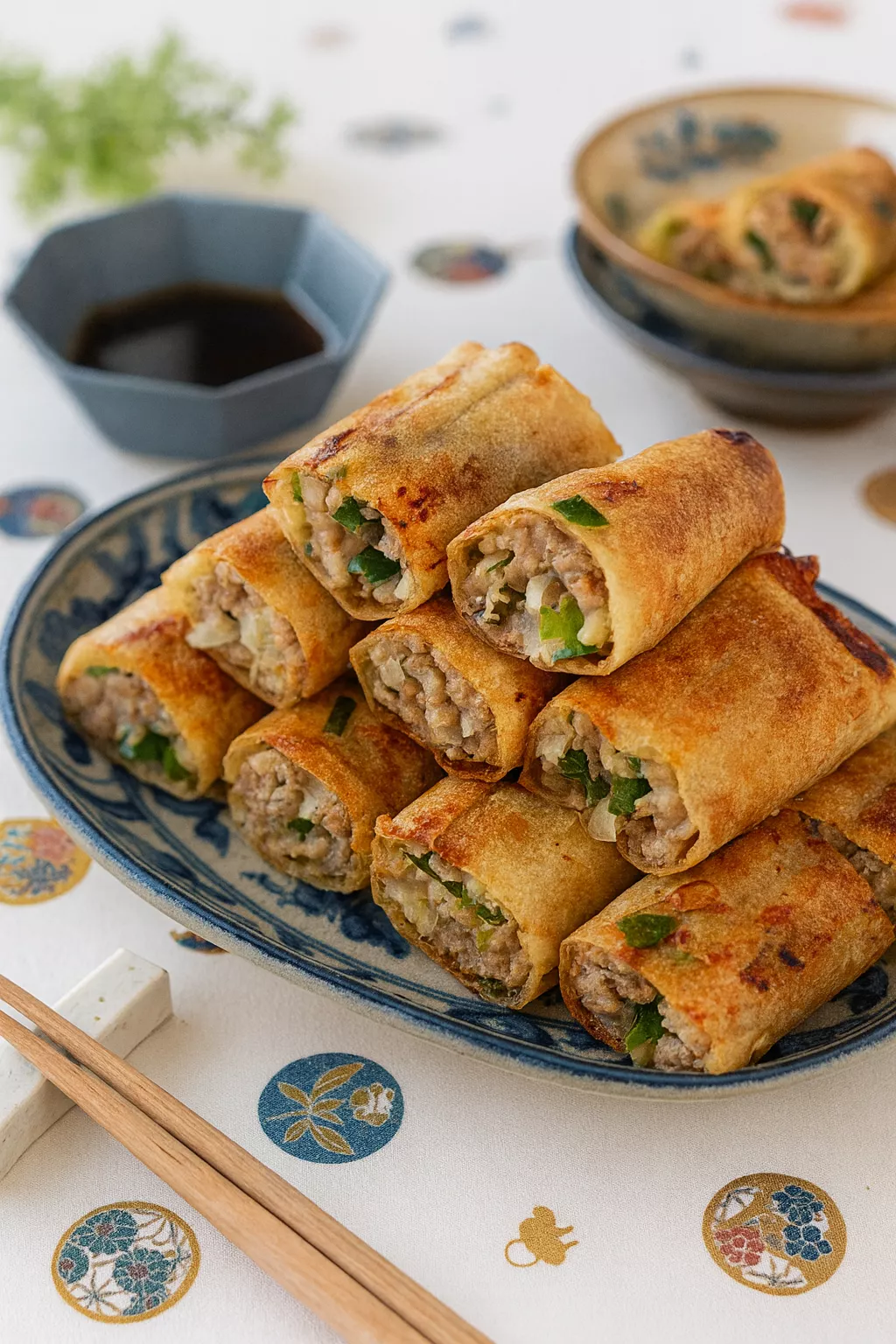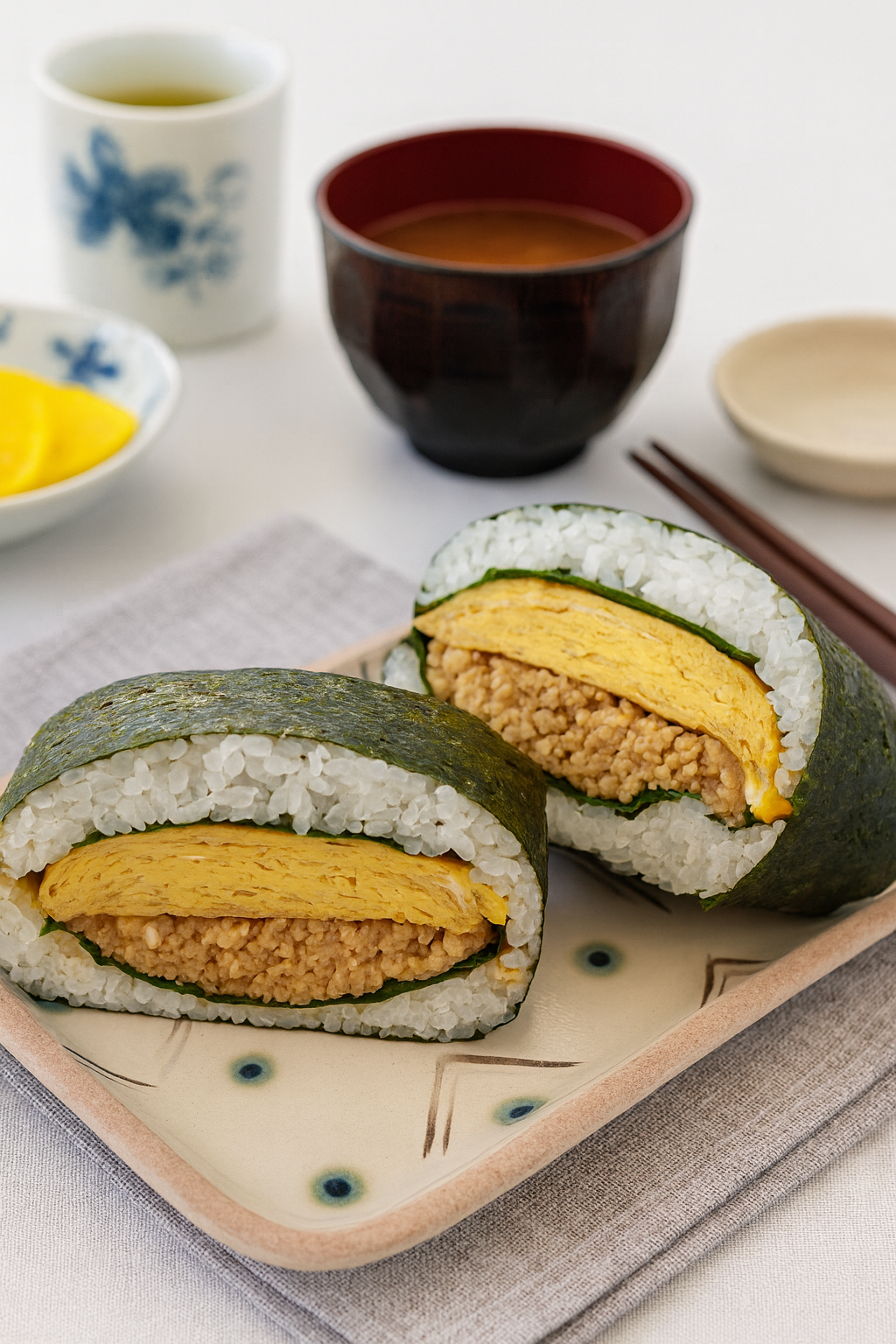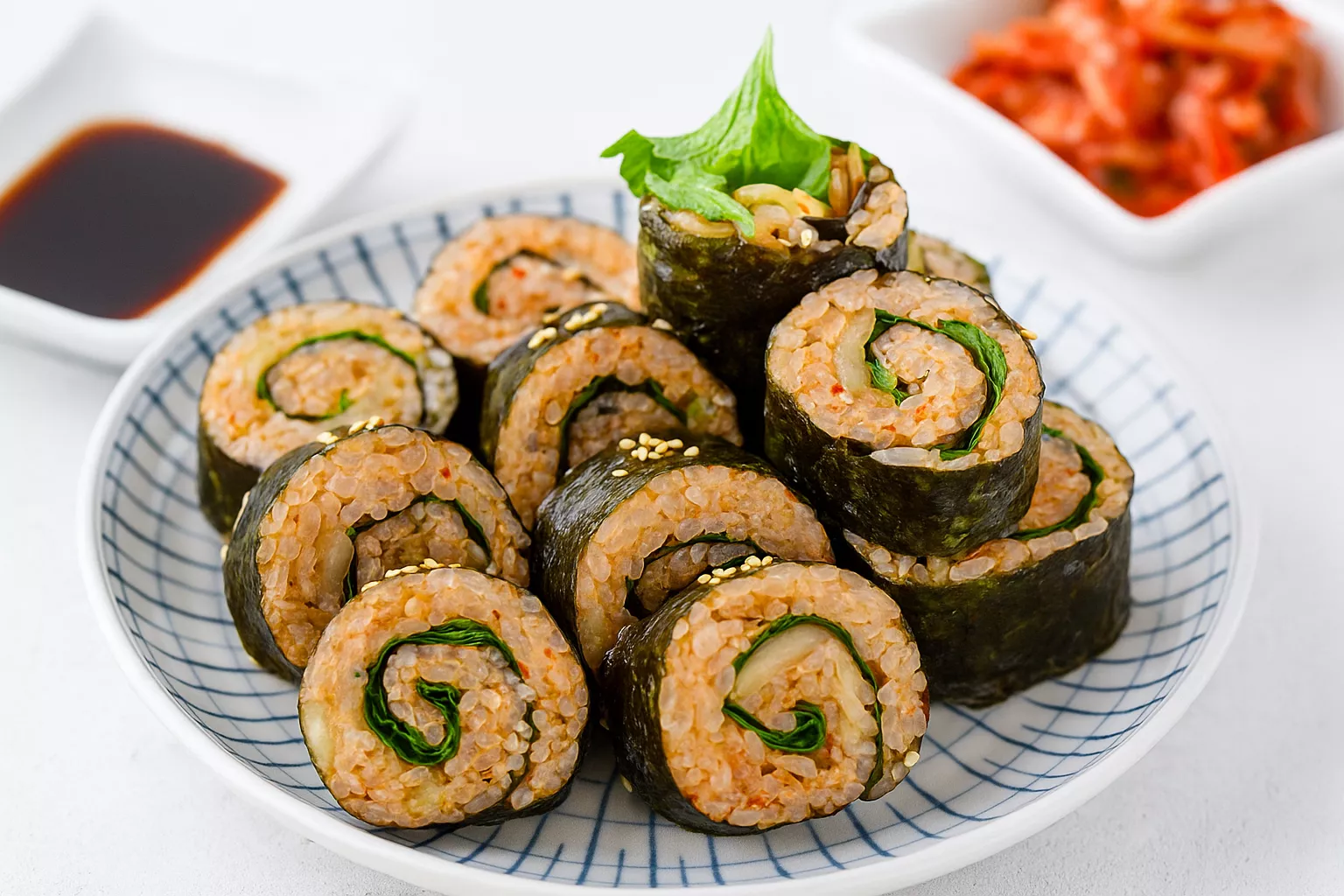Have you ever wondered why Japanese people eat a long sushi roll in complete silence while facing a certain direction once a year? It might sound mysterious—but this tasty tradition is known as Setsubun Sushi Roll (節分巻き寿司). What’s the story behind it? Why is it eaten whole, without slicing? And how can you make this special roll at home easily? Let’s uncover the answers together while learning how to prepare this delicious, lucky sushi roll that celebrates spring and good fortune!
What Makes This Recipe Special
The Setsubun Sushi Roll isn’t just another sushi roll—it’s a symbol of luck, prosperity, and new beginnings. Every year on February 3rd, families in Japan celebrate Setsubun (節分), meaning “seasonal division.” It marks the end of winter and the start of spring according to the lunar calendar.
During this day, people perform rituals like throwing roasted soybeans (mamemaki) to drive away evil spirits while shouting, “Oni wa soto! Fuku wa uchi!” (“Demons out! Good luck in!”). Another tradition is eating a whole sushi roll, known as Ehomaki (恵方巻き)—or the Setsubun Sushi Roll—while facing the year’s lucky direction.
This recipe is simple, requires about 30 minutes, and is beginner-friendly. You don’t need a sushi mat or special tools—just some nori (seaweed sheets), rice, and a few tasty fillings like tuna, kimchi, and perilla leaves.

Setsubun Sushi Roll (節分巻き寿司) @JapanDishes
What Is Setsubun Sushi Roll (節分巻き寿司)?
The Setsubun Sushi Roll originated in the Kansai region of Japan but is now enjoyed nationwide. Traditionally, it’s made with seven ingredients, representing the Seven Lucky Gods (Shichifukujin) of Japanese folklore. However, modern variations include flavorful fillings such as tuna and kimchi, adding a Korean-inspired twist that perfectly matches today’s taste trends.
The key to enjoying Setsubun Sushi Roll is not cutting it—because slicing is believed to “cut” away good fortune. Instead, you hold the entire roll and take silent bites while making a wish for happiness, success, or good health throughout the year.
Essential Ingredients
Here’s everything you’ll need to make your own lucky roll at home.
Ingredients
- Cooked rice – 240g
The base of your sushi roll. Slightly warm rice sticks together better and helps the fillings stay firm inside. - Whole seaweed (nori) – 2 sheets
These sheets wrap the rice and fillings, keeping the roll intact and adding a mild, ocean flavor. - Kimchi – 100g
Adds a spicy, tangy kick. Its flavor balances the richness of the tuna and the fragrance of sesame oil. - Canned tuna – 1 can (about 70g)
A quick, protein-packed filling that pairs beautifully with kimchi. - Sesame oil – ½ tablespoon
Gives the rice a nutty aroma and smooth texture. - Salt – A pinch
Enhances all the flavors in the roll. - Perilla (shiso) leaves – 6 sheets
Their refreshing herbal flavor adds a traditional Japanese touch. - Roasted sesame seeds (for finishing) – Appropriate amount
Used for coating or sprinkling on the roll for texture and presentation.
Substitutions and Variations
- Rice alternatives: You can use short-grain brown rice or sushi rice mixed with quinoa for a healthier twist.
- Protein swaps: Try salmon flakes, crab sticks, or egg omelets if you’re not a fan of tuna.
- Vegetarian option: Replace tuna with avocado slices, cucumber, or grilled tofu for a plant-based roll.
- Flavor additions: Add a touch of mayonnaise or spicy sauce to the tuna mixture for extra richness.
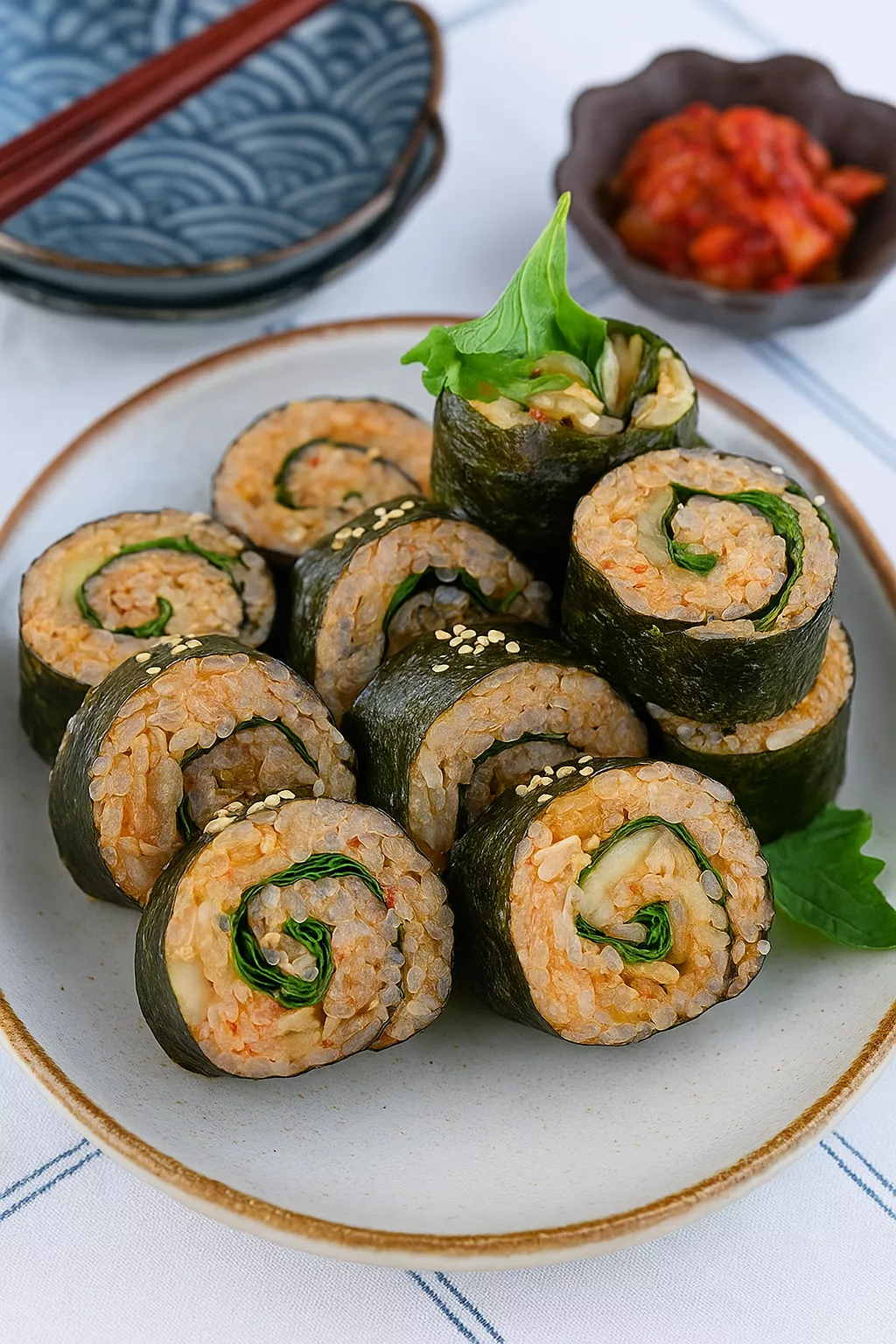
Step-by-Step Instructions
Follow these easy steps to create your own Setsubun Sushi Roll at home.
Step 1: Prepare the Kimchi
Place the kimchi in a large bowl. Using kitchen scissors, cut any large pieces into bite-sized chunks. This ensures even distribution and makes rolling easier.
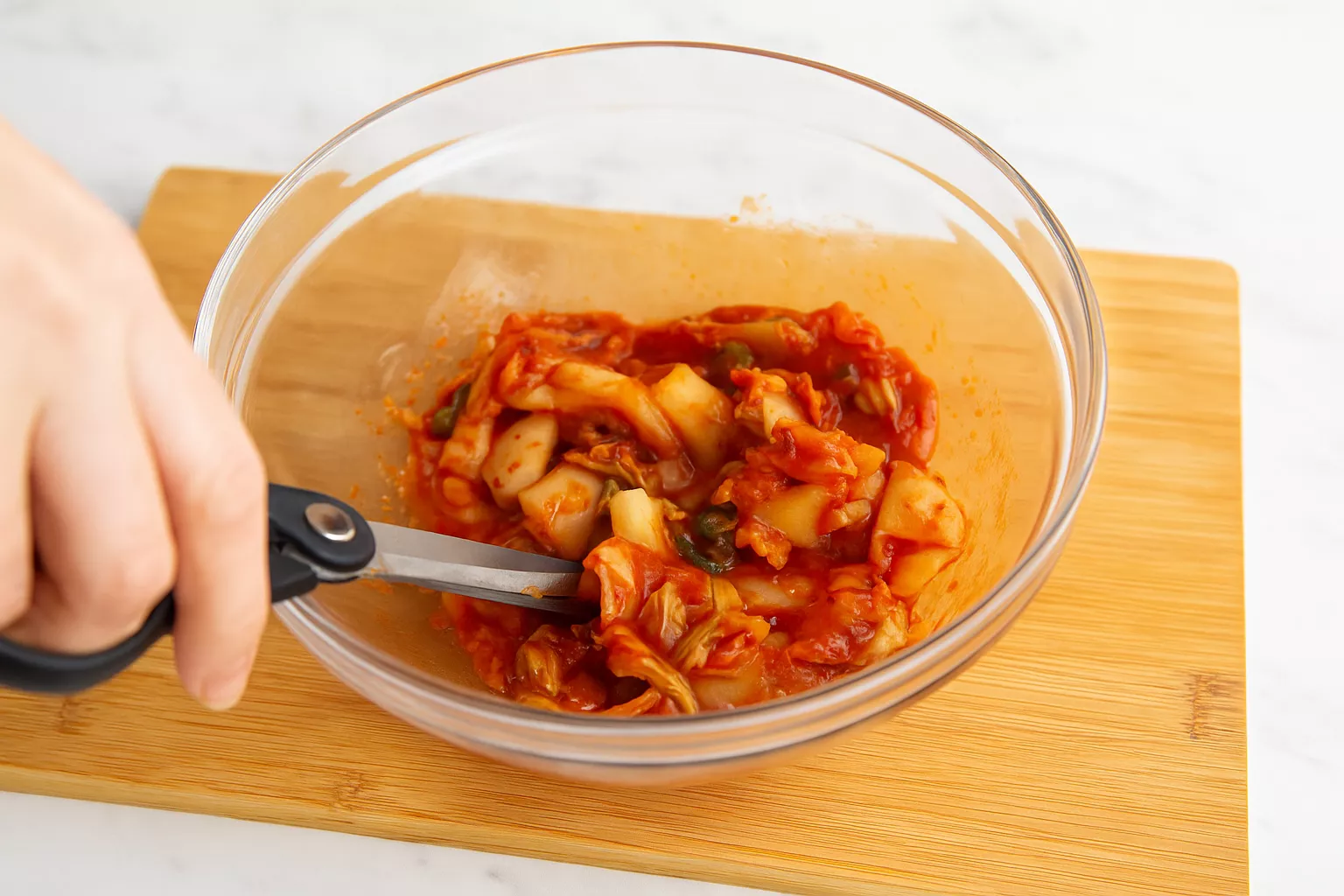
Tip: Lightly squeeze out excess liquid from the kimchi before adding it to the rice—too much moisture can make the roll soggy.
Step 2: Mix the Rice
Drain your canned tuna and add it to the bowl with kimchi. Add the warm rice, sesame oil, and salt. Mix gently until all ingredients are evenly combined.
This mixture will form both the filling and the flavored rice layer, giving your sushi a balanced, seasoned taste.
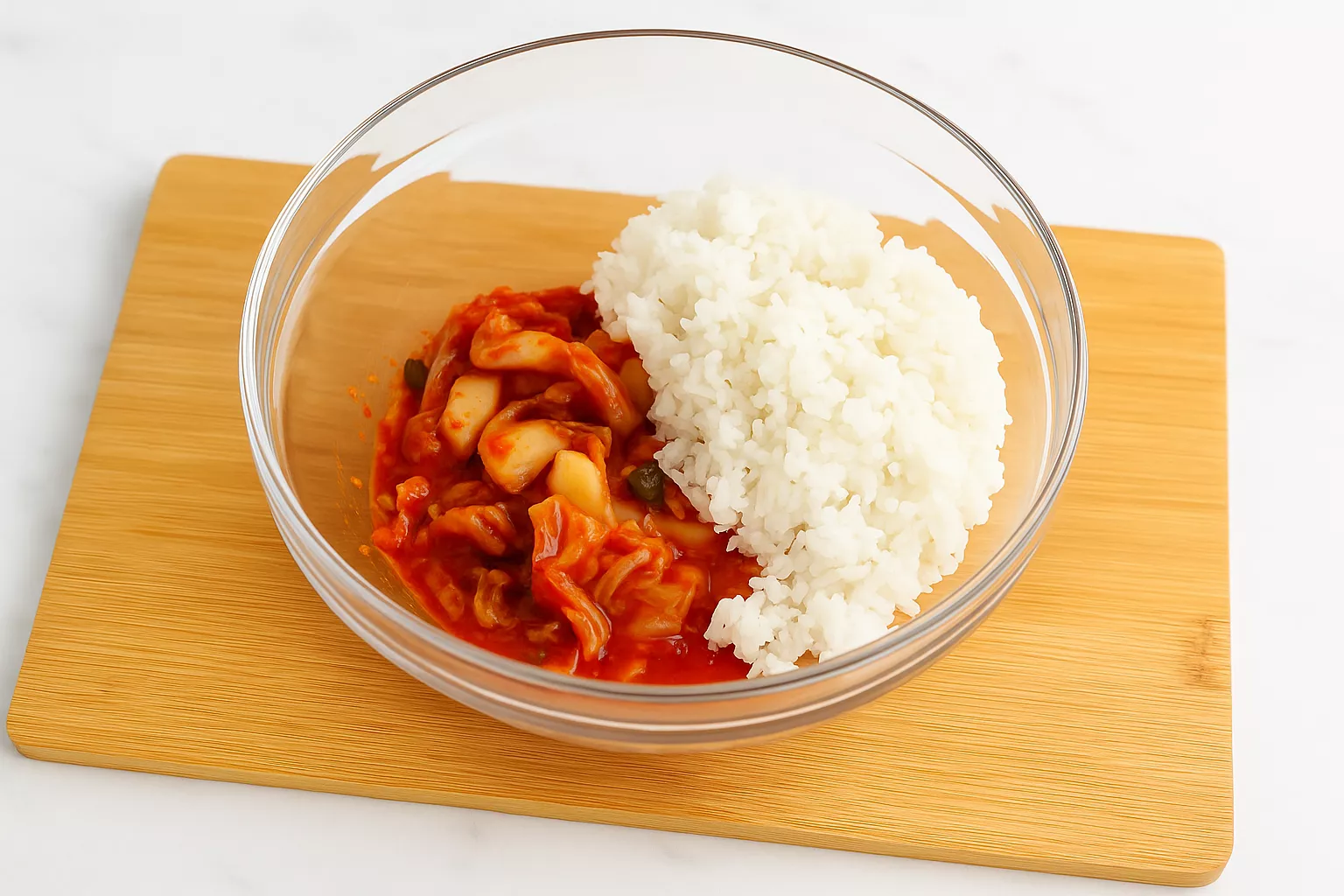
Pro tip: Don’t mash the rice; keep the grains slightly firm to preserve their texture.
Step 3: Prepare the Rolling Base
Lay a sheet of plastic wrap on a flat surface and place a whole sheet of nori on top. Spread the kimchi-tuna rice mixture evenly across the nori, leaving about 1 cm of space at the top edge.

This gap prevents the filling from spilling out when rolling.
Step 4: Add the Perilla Leaves
Lay three shiso (perilla) leaves horizontally across the front side of the nori. Their fresh, herbal aroma gives a distinctly Japanese flavor to your roll.
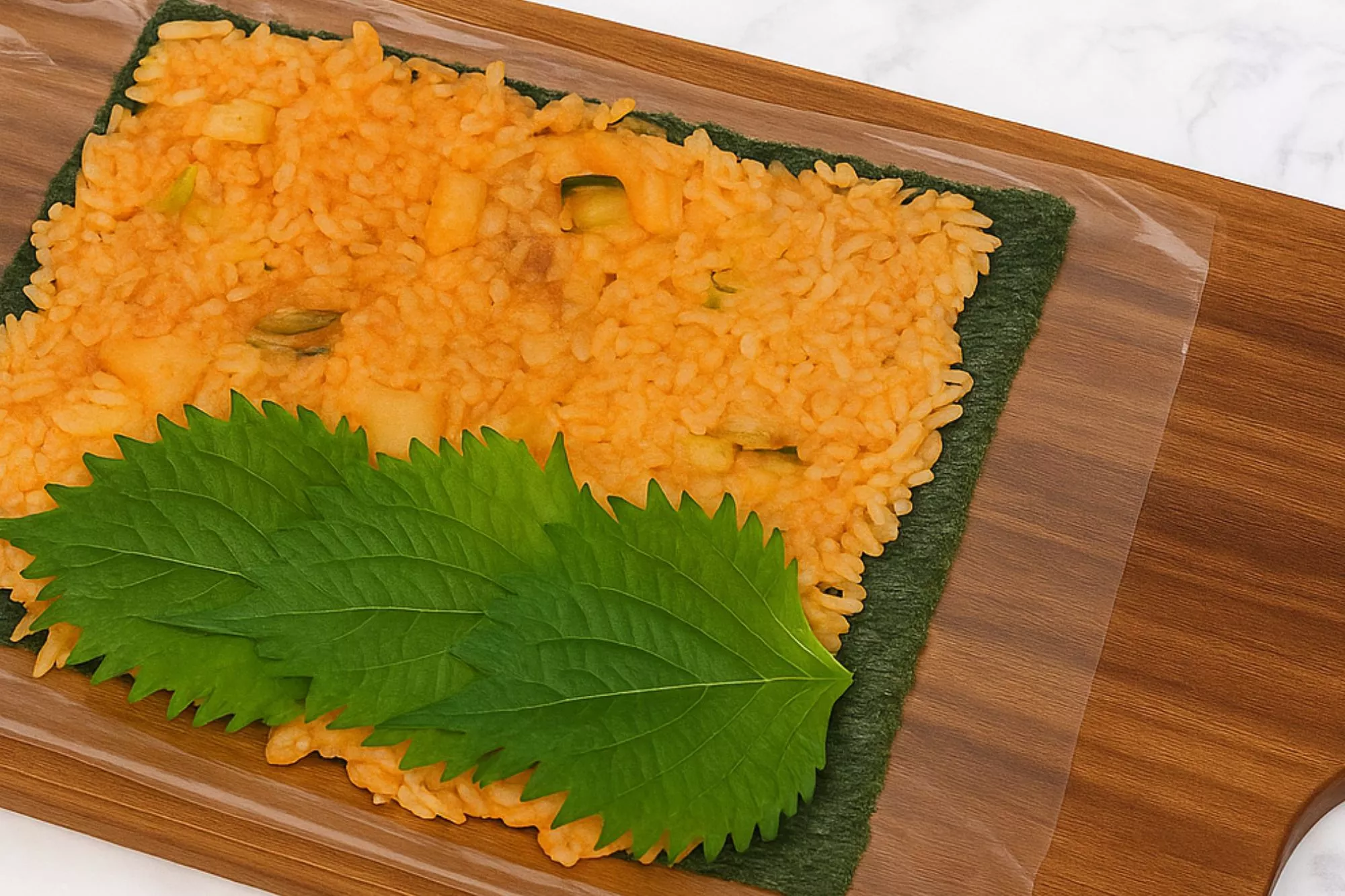
Step 5: Roll It Up
Starting from the edge with the perilla leaves, gently roll the nori toward the opposite end, pressing lightly as you go. Use the plastic wrap to help shape it into a firm, even cylinder.

Tip: Apply gentle pressure while rolling to keep the ingredients compact, but don’t squeeze too tightly, or the rice may break through the nori.
Step 6: Rest and Slice
Wrap the sushi roll in plastic wrap and let it rest for about 10 minutes. This allows the flavors to blend and the nori to soften slightly.

After resting, carefully unwrap it and, if you like, cut it into bite-sized rounds. However, during Setsubun, the roll is traditionally eaten whole for good luck.
Step 7: Finishing Touches
Brush a small amount of sesame oil over the roll’s surface and sprinkle roasted sesame seeds on top. This adds shine, aroma, and a satisfying crunch.
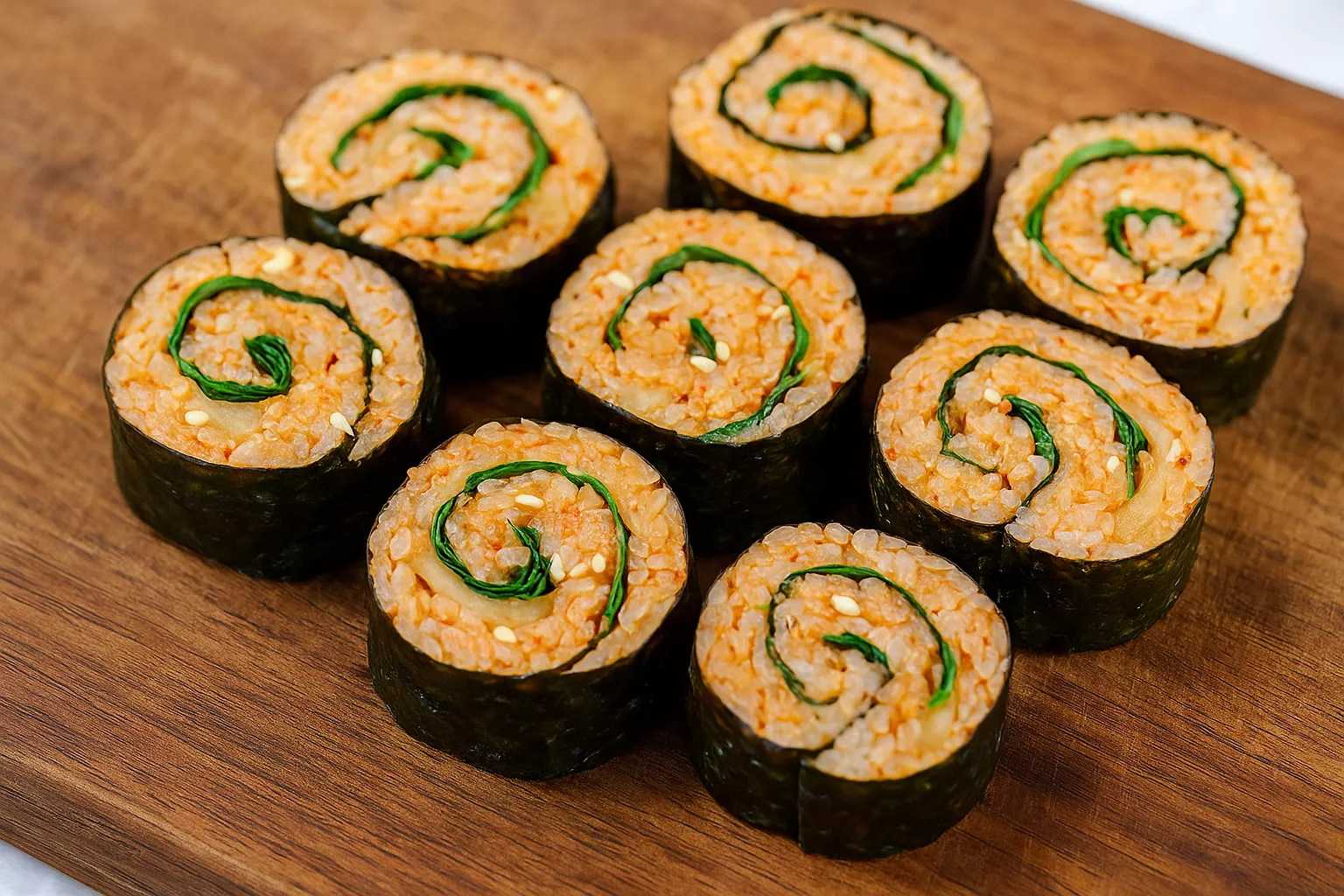
Secrets to Success and Expert Tips
- Use freshly cooked rice: Slightly warm rice makes it easier to spread and stick. Cold rice tends to crumble.
- Balance the flavors: The strong flavor of kimchi pairs perfectly with the mildness of tuna—don’t overdo the kimchi or it can overpower the roll.
- Keep the moisture low: Too much liquid from kimchi or tuna can make your nori soggy. Drain well.
- Avoid overfilling: A neat roll depends on the right filling-to-rice ratio—too much filling makes it burst open.
- Wrap tightly but gently: The plastic wrap helps maintain the shape without squashing the ingredients.
- Serve immediately: The nori is best enjoyed when it’s slightly soft but not soggy.
Assembly
Once you’ve prepared your ingredients, it’s time to assemble your roll like a pro!
How to Assemble
- Lay the nori shiny side down on a bamboo sushi mat or directly on plastic wrap.
- Spread your kimchi-tuna rice mixture evenly across the sheet, leaving a 1 cm border at the top.
- Place three shiso leaves in a horizontal line near the bottom.
- Using the mat or plastic wrap, roll it from bottom to top in a tight, even motion.
- Press gently to keep the roll cylindrical and firm.
For a professional presentation, lightly coat the finished roll with sesame oil and sprinkle roasted sesame seeds on top. This not only enhances flavor but gives your sushi a glossy, restaurant-like finish.
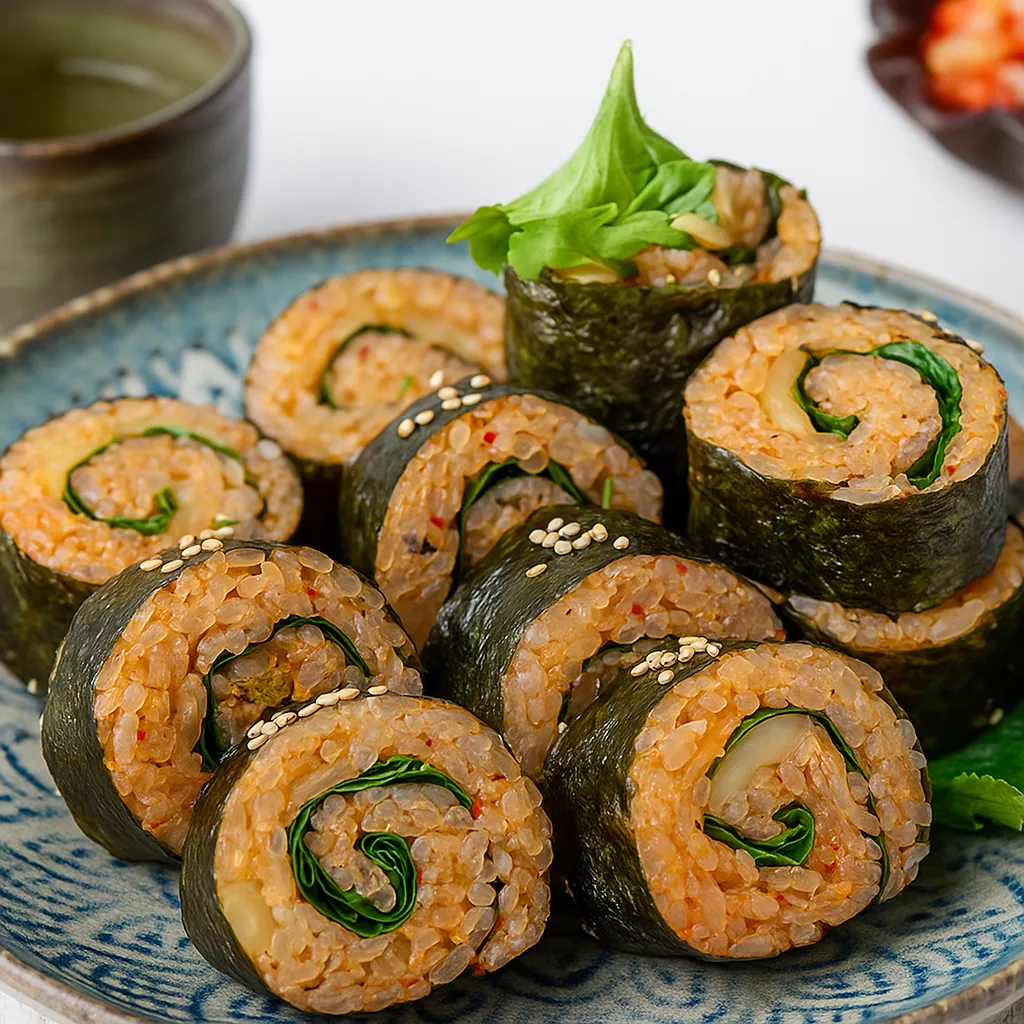
Setsubun Sushi Roll (節分巻き寿司)
Hana’s Recipe Tips
As Hana from JapanDishes always says, the beauty of homemade sushi lies in simplicity and balance.
- Warm rice, cold fillings: Keep the rice slightly warm and the fillings cool for the best texture.
- Fresh herbs: Shiso leaves make a big difference—if unavailable, use fresh basil for a similar aroma.
- Add color: Roll variations with egg omelets or cucumbers add vibrant colors and nutrition.
- Serve creatively: Slice into bite-size rounds and display them on a Japanese ceramic plate for a traditional look.
Remember, cooking at home is not about perfection—it’s about enjoying the process and sharing joy.
Storage and Make-Ahead Tips
- Refrigeration: Wrap leftover sushi tightly in plastic wrap and store it in the refrigerator for up to 24 hours.
- Prevent dryness: Place a damp paper towel inside the container to keep the rice from drying out.
- Reheating: Sushi rolls are best eaten fresh, but if you want to refresh the texture, let them come to room temperature before serving—do not microwave.
- Make-ahead idea: You can prepare the rice mixture and fillings a few hours in advance. Assemble just before eating to keep the nori crisp.
Recipe Variations
Want to add your own twist? Try these creative versions:
- Vegetable Setsubun Roll: Replace tuna with avocado, cucumber, and bell pepper for a colorful vegetarian roll.
- Spicy Tuna Roll: Mix tuna with Japanese mayonnaise and a dash of chili sauce for extra heat.
- Salmon and Cream Cheese Roll: Add thin salmon slices and cream cheese for a creamy, savory treat.
- Egg and Spinach Roll: Combine tamagoyaki (Japanese rolled omelet) and sautéed spinach for a soft, mild filling.
- Sweet & Savory Roll: Mix cooked eel with cucumber and egg omelet for a taste similar to classic futomaki.
Each variation still captures the spirit of Setsubun—welcoming good fortune in your own delicious way.
More Japanese Roll Recipes to Try
If you enjoyed making this Setsubun Sushi Roll 節分巻き寿司, you might also love trying other Japanese roll recipes. For a fun spring twist, check out the Spring Gyoza Roll Recipe it’s crispy, colorful, and perfect for seasonal gatherings. Or, if you prefer something more hearty, try the Japanese Chicken Onigirazu Recipe, a tasty rice sandwich that’s easy to pack for lunch or picnics.
Conclusion
The Setsubun Sushi Roll (節分巻き寿司) is more than just a dish—it’s a celebration of hope, renewal, and happiness. By making it at home, you’re not only learning a traditional Japanese recipe but also experiencing a cultural ritual that connects food with meaning.
So next time February 3rd comes around, gather your ingredients, face the year’s lucky direction, and take a quiet bite of your homemade roll. Feel the crunch of the nori, the warmth of the rice, and the zest of the kimchi—and remember, each bite carries a wish for a joyful year ahead.
Now that you know how simple and fun it is, why not try this Setsubun Sushi Roll for your next family meal or party? You’ll bring good luck, laughter, and flavor to your table.
And if you’re dreaming of visiting Japan someday, don’t miss the breathtaking scenery of Yamadera a peaceful mountain temple known for its stunning views and tranquil atmosphere.
Frequently Asked Questions (FAQs)
1. What is the meaning of Setsubun Sushi Roll?
It’s a sushi roll eaten on Setsubun day (February 3rd) to bring good luck for the new season. People eat it whole, facing the year’s lucky direction, without talking.
2. Why can’t I cut the roll?
Cutting the roll symbolizes cutting off your luck. Eating it whole keeps your fortune intact for the year.
3. Can I make this roll in advance?
Yes! You can prepare the fillings ahead and assemble just before eating. Store leftovers in the refrigerator for up to a day.
4. Is Setsubun Sushi Roll healthy?
Absolutely. It’s packed with protein from tuna, vitamins from kimchi, and fiber from seaweed and rice. Using minimal oil keeps it light yet satisfying.
5. What direction should I face when eating?
Each year has a different lucky direction based on the zodiac. In Japan, people check the year’s “Eho” and face that way while eating silently.
6. Can I use other fillings like avocado or egg?
Yes! Feel free to experiment with your favorite fillings. The key is to keep a good balance of flavor and texture.
7. What’s the difference between Setsubun Sushi Roll and regular sushi?
Regular sushi can be sliced and served in pieces, but Setsubun Sushi Roll is eaten whole as part of a traditional celebration.
8. How long does it take to make?
It takes about 30 minutes from start to finish—perfect for a quick, meaningful meal.
Setsubun Sushi Roll 節分巻き寿司
Course: AppetizersCuisine: JapaneseDifficulty: Easy4–6
servings20
minutes10
minutes320
kcalCelebrate Japan’s spring festival with this easy and flavorful Setsubun Sushi Roll 節分巻き寿司! Filled with tuna, kimchi, and shiso leaves, this lucky roll is simple to make and perfect for welcoming good fortune into your home.
Ingredients
240g cooked rice (slightly warm)
2 sheets whole seaweed (nori)
100g kimchi (cut into bite-sized pieces)
1 can tuna (about 70g, drained)
½ tablespoon sesame oil
A pinch of salt
6 shiso (perilla) leaves
Roasted sesame seeds (for garnish)
Extra sesame oil (for finishing)
Directions
- Prepare the kimchi.
Place kimchi in a bowl and cut large pieces into smaller bites using kitchen scissors. Gently squeeze out excess liquid to prevent sogginess. - Make the rice mixture.
Add drained tuna to the kimchi bowl. Mix in the cooked rice, sesame oil, and salt. Stir gently until well combined, keeping the rice grains intact. - Set up your rolling base.
Lay a sheet of plastic wrap on a flat surface, then place one nori sheet shiny side down. Spread the rice mixture evenly, leaving a 1 cm gap at the top edge. - Add the perilla leaves.
Lay three shiso leaves horizontally across the bottom edge of the rice. Their aroma adds a refreshing flavor. - Roll the sushi.
Starting from the edge with the shiso, roll the nori toward the top using the plastic wrap for support. Apply light pressure to form a firm, even roll. - Let it rest.
Wrap the roll in plastic wrap and let it rest for 10 minutes. This helps the flavors blend and the nori soften slightly. - Finish and serve.
Remove the wrap, brush the roll lightly with sesame oil, and sprinkle roasted sesame seeds on top. Slice into pieces if desired—or enjoy it whole as tradition suggests for good luck!
Notes
- ✪ Eat the roll whole during Setsubun to keep your good fortune unbroken.
✪ Drain kimchi and tuna well to avoid a soggy roll.
✪ You can swap tuna for crab sticks, salmon, or tofu for variation.
✪ Store leftovers tightly wrapped in the refrigerator for up to 24 hours.

